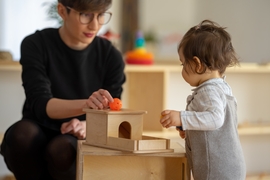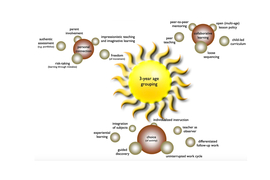
Montessori environments for infants and toddlers are prepared to be as homelike as possible, and to involve small children in a round of daily activities including quiet times and rest periods. The characteristics of these environments include:
- continuity of care
- an ordered physical environment
- consistency of activity and expectation.
In environments with these characteristics infants build a sense of security, a sense of order and a sense of time.
Continuity of care lays the foundation for emotional and social wellbeing. If infants interact with the same people day after day, they feel secure, and they have the opportunity to build lasting relationships and social bonds they can depend on.
An ordered physical environment lays the foundation of an ordered mind. If infants find things in the same place day after day, they learn to recognise those things and where they belong. In such an environment children grow confident in their ability to know and memorise things, in other words, they become confident in their own intellectual capacity.
Similarly, consistency of activity contributes to children’s security and intellectual confidence. A daily routine develops in infants an understanding of the passing of time. If, day after day, infants follow the same routines at the same time and the same places, they have further opportunity to discover that they know something when they recognise familiar things and events. If infants take part in the same activities, in the same order day after day, they further consolidate their sense of security, order and time.
There are two prepared environments for infants and toddlers under the age of three years:
- The Nido, or nest, is a nurturing home-like environment for infants from 2 to 3 months until they are walking independently (around 15/18 months).
- The Infant Community is an educational environment prepared for toddlers from the time they are walking independently until they are approximately three years of age. It is a nurturing environment where very young children experience their first structured contact with other children. The focus of the environment is to offer children activity that supports the development of voluntary, controlled movement, spoken language and independence in daily life.
Both these environments are organised and directed by a Montessori trained adult called an Assistant to Infancy. Nidos and Infant Communities can be prepared so children can attend on their own (for example, in sessional or long day care) or so parents can accompany the children. When parents accompany children to the Nido, the group is often called a ‘parent-infant group’. When parents accompany children to the Infant Community, the group is often called a ‘parent-toddler group’. The accompanying parents gain information about ways to interact with children based on the modelling of this behaviour provided by the staff. In addition, in this environment parent and child experience a protected time in which their relationship to each other can deepen and grow.
Activities in Montessori environments for children under the age of three are related to real life. They provide children with opportunities to develop voluntary, controlled movement, independence in daily life and spoken language.
Order is a feature of all Montessori early childhood environments. The ability of the child to create order from the stimuli of the environment is an essential factor in normal development from birth to three years.
In addition, parent information sessions and literature also provide an essential component of Montessori early childhood environments prepared for infants and toddlers.



